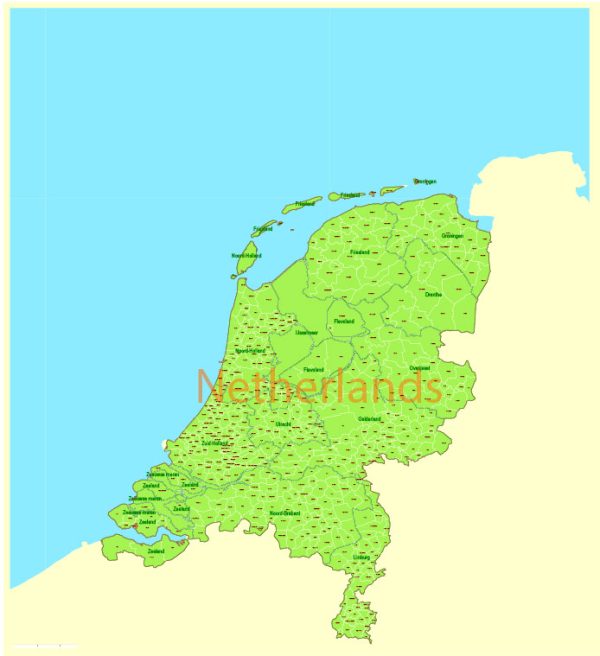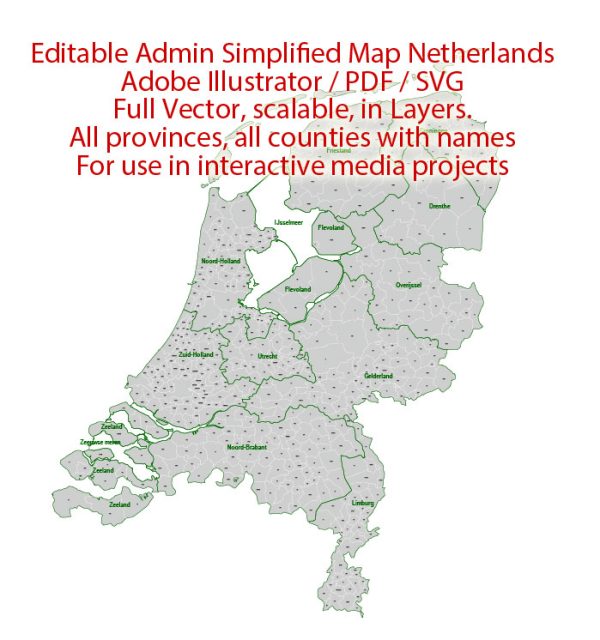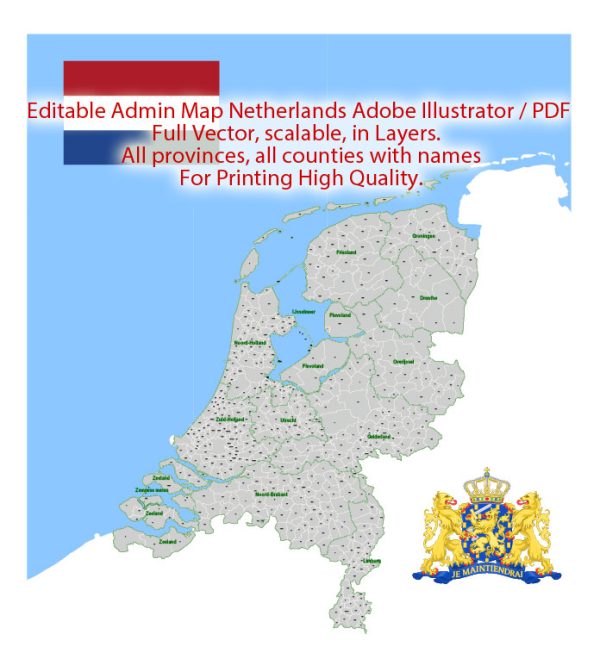History of the Netherlands
The history of the Netherlands is rich and complex, shaped by its geographical location, interactions with neighboring countries, and internal developments. Below is an overview of the key historical periods that have influenced the country.
Vectormap.Net provide you with the most accurate and up-to-date vector maps in Adobe Illustrator, PDF and other formats, designed for editing and printing. Please read the vector map descriptions carefully.
Early History and Medieval Period
- Prehistory and Roman Era: The region now known as the Netherlands has been inhabited for thousands of years. During the Roman era, the southern part of the country was part of the Roman Empire, while the northern regions remained largely outside Roman control, inhabited by Germanic tribes.
- Franks and Carolingian Empire: After the fall of the Roman Empire, the area became part of the Frankish Kingdom. During the Carolingian period (8th-9th centuries), the region was integrated into the Holy Roman Empire. The rise of Christianity also marked this period, with the establishment of monasteries and churches.
- Feudal Fragmentation: By the Middle Ages, the Low Countries (including the Netherlands) were divided into various feudal territories, such as the County of Holland, the Duchy of Brabant, and the Bishopric of Utrecht. These regions were part of the Holy Roman Empire but operated with significant autonomy.
The Dutch Golden Age
- Burgundian and Habsburg Rule (15th-16th centuries): The Low Countries were united under the Burgundian and later Habsburg rule, creating a unified political entity. However, the imposition of heavy taxes and attempts to suppress Protestantism led to growing discontent.
- Eighty Years’ War and Independence (1568-1648): The Eighty Years’ War, also known as the Dutch Revolt, was a protracted conflict against Spanish rule. The conflict culminated in the independence of the northern provinces, which declared independence as the Dutch Republic in 1581. The Treaty of Westphalia in 1648 officially recognized this independence.
- The Dutch Golden Age (17th century): The 17th century marked the height of Dutch power and influence. The Netherlands became a global maritime and economic power, with Amsterdam emerging as a major financial center. Dutch explorers and merchants established colonies and trade routes worldwide, particularly in Asia, Africa, and the Americas. The Dutch East India Company (VOC) played a central role in this expansion.
- Cultural Flourishing: The Golden Age was also a period of cultural flourishing, with significant achievements in art, science, and literature. Renowned painters like Rembrandt, Vermeer, and Frans Hals created masterpieces that remain central to Dutch cultural heritage.
18th and 19th Centuries
- Decline and Foreign Rule: The 18th century saw the decline of the Dutch Republic, as it faced competition from emerging powers like Britain and France. The country was briefly occupied by French forces during the Napoleonic Wars, leading to the establishment of the Batavian Republic (1795) and later the Kingdom of Holland under Napoleon’s brother, Louis Bonaparte.
- Kingdom of the Netherlands (1815): After the defeat of Napoleon, the Congress of Vienna in 1815 established the Kingdom of the Netherlands, which included present-day Belgium. However, Belgium gained independence in 1830, and the Netherlands became a constitutional monarchy under King William I.
- Industrialization and Social Change: The 19th century saw the gradual industrialization of the Netherlands, with the development of industries like textiles, shipbuilding, and trade. The country also experienced significant social and political changes, including the expansion of voting rights and the rise of political parties.
20th Century to Present
- World Wars: The Netherlands remained neutral during World War I but was occupied by Nazi Germany during World War II. The occupation was brutal, leading to significant resistance and suffering, particularly during the “Hunger Winter” of 1944-45. The country was liberated by Allied forces in 1945.
- Post-War Recovery: After World War II, the Netherlands underwent rapid reconstruction and economic growth. The country became a founding member of NATO, the European Economic Community (EEC), and later the European Union (EU). The Dutch welfare state expanded during this period, with significant investments in healthcare, education, and social services.
- Modern Era: In recent decades, the Netherlands has become known for its progressive social policies, including legalizing same-sex marriage, euthanasia, and recreational drug use. The country remains a global financial and cultural center, with a high standard of living and strong international ties.
Road System of the Netherlands
The Netherlands boasts one of the most advanced and efficient road systems in the world. Given the country’s dense population and small geographical size, the road network is crucial for both domestic travel and international trade.
Overview of the Road System
- Highway Network (Autosnelwegen): The Netherlands has an extensive highway network, known as “autosnelwegen,” which are designated with the letter “A” followed by a number (e.g., A1, A2). These highways are typically multi-lane roads with high-speed limits, connecting major cities and facilitating rapid travel across the country.
- Provincial Roads (N-wegen): Provincial roads, designated with the letter “N” followed by a number (e.g., N201), connect towns, smaller cities, and rural areas. These roads are vital for regional connectivity and often complement the national highway network.
- Urban Roads: In cities and towns, the road network is well-organized, with a clear hierarchy of roads from major arterial routes to local streets. Urban roads are typically well-maintained, with a focus on safety for all users, including pedestrians and cyclists.
- Cycling Infrastructure: The Netherlands is world-renowned for its cycling infrastructure. Nearly every road has a dedicated cycle path (fietspad), and cities are designed with cyclists in mind. Cycling is a major mode of transportation, and the extensive network of cycle paths is integrated with public transit and road systems.
Key Highways and Roads
- A1: One of the primary east-west routes, the A1 connects Amsterdam to the German border, passing through cities like Amersfoort and Apeldoorn. It is a major route for both passenger and freight traffic.
- A2: This major north-south highway runs from Amsterdam to Maastricht, passing through Utrecht and Eindhoven. The A2 is one of the busiest highways in the country, particularly in the Randstad region.
- A4: Connecting Amsterdam with The Hague, Rotterdam, and further south to the Belgian border, the A4 is critical for traffic between the major cities in the western Netherlands.
- A12: The A12 runs from The Hague to the German border, passing through Utrecht and Arnhem. It is an important route for traffic moving from the west to the east of the country.
Road Maintenance and Innovations
- Maintenance: The Dutch road system is known for its high standards of maintenance. Roads are regularly inspected and repaired, with a focus on minimizing disruptions to traffic. The country’s flat terrain makes road construction relatively straightforward, but the high water table requires constant attention to drainage and roadbed stability.
- Innovations: The Netherlands has been at the forefront of road infrastructure innovations. The country has experimented with “smart highways” that use dynamic lighting, temperature-responsive road markings, and energy-harvesting technologies. There are also ongoing efforts to increase the sustainability of road construction and maintenance, including the use of recycled materials and eco-friendly designs.
- Traffic Management: Given the high population density, traffic management is crucial. The Netherlands uses advanced traffic monitoring systems, dynamic speed limits, and congestion management strategies to keep traffic flowing smoothly. Public transit is also heavily integrated with the road network, providing alternatives to car travel and reducing congestion.
Conclusion
The Netherlands’ road system is a testament to the country’s commitment to efficiency, innovation, and sustainability. With its extensive highways, well-maintained provincial roads, and world-class cycling infrastructure, the Dutch road network is a critical component of the country’s transport infrastructure. This road system supports not only domestic travel and commerce but also the Netherlands’ role as a key transit hub in Europe.




 Author: Kirill Shrayber, Ph.D.
Author: Kirill Shrayber, Ph.D.